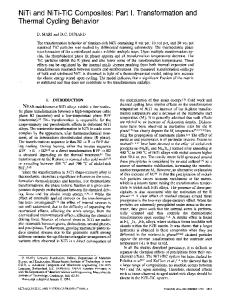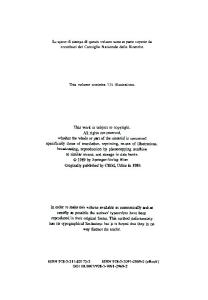Niti and NiTi-TiC composites: Part II. compressive mechanical properties
- PDF / 1,564,306 Bytes
- 9 Pages / 597.28 x 777.28 pts Page_size
- 102 Downloads / 488 Views
I.
INTRODUCTION
NEAR-equiatomic NiTi alloys exhibit in the vicinity of room temperature a thermoelastic, allotropic phase transformation between an ordered, high-temperature austenitic phase with B2 cubic structure and an ordered, low-temperature martensitic phase with monoclinic B19' structure. While slip by dislocation motion is activated in these alloys at high applied stresses, other deformation mechanisms can dominate at lower applied stresses: twinning for martensitic NiTi and formation of stress-induced martensite for austenitic NiTi, as reviewed recently in, e.g., References 1 through 8. In both cases, the strain accumulated by these nonslip deformation mechanisms can be fully recovered upon reverse phase transformation to austenite: by temperature-induced transformation upon heating of the twinned martensite (shape-memory recovery) or by stress-induced transformation upon unloading of stress-induced martensite (superelastic recovery). Furthermore, twinned martensite can also exhibit detwinning upon unloading (rubberlike recovery). As for most other metal matrix composite systems, the presence of a ceramic second phase within the NiTi matrix can result in a composite with decreased density and increased strength, stiffness, hardness, and abrasion resis-
K.L. FUKAMI-USHIRO, formerly Graduate Student, Department of Materials Science and Engineering, Massachusetts Institute of Technology, is Development Engineer with Raychem Corp., Menlo Park, CA 94025. D. MAR1, formerly Postdoctoral Fellow, Department of Materials Science and Engineering, Massachusetts Institute of Technology, is CEO with Advanced Composite Materials Engineering, 1015 Lausanne, Switzerland. D.C. DUNAND, AMAX Assistant Professor, is with the Department of Materials Science and Engineering, Massachusetts Institute of Technology, Cambridge, MA 02139. Manuscript submitted March 14, 1995. METALLURGICAL AND MATERIALSTRANSACTIONS A
tance.t9] However, unlike composites with matrices deforming solely by slip, the alternative deformation mechanisms described previously (twinning and stress-induced transformation) are expected to be operative in NiTi composites during both the overall deformation of the matrix (driven by the external stress) and its local deformation near the reinforcement (controlled by the mismatch stresses between matrix and reinforcement). An examination of the literature reveals that the influence of internal stresses on the deformation behavior of NiTi-based composites has not been examined by the few investigators who have studied such composites to date. References 10 and 11 characterize the mechanical properties of sintered TiC-NiTi cermets and show that with decreasing TiC content, the hardness and compressive strength decrease, while the ductility and toughness increase. In studying the strengthening and stiffening of aluminum containing continuous and discontinuous NiTi fibers, References 12 and 13 give calculations of the internal stresses resulting from the phase transformation of the fibers. Bidaux et aLtO4] investiga
Data Loading...











